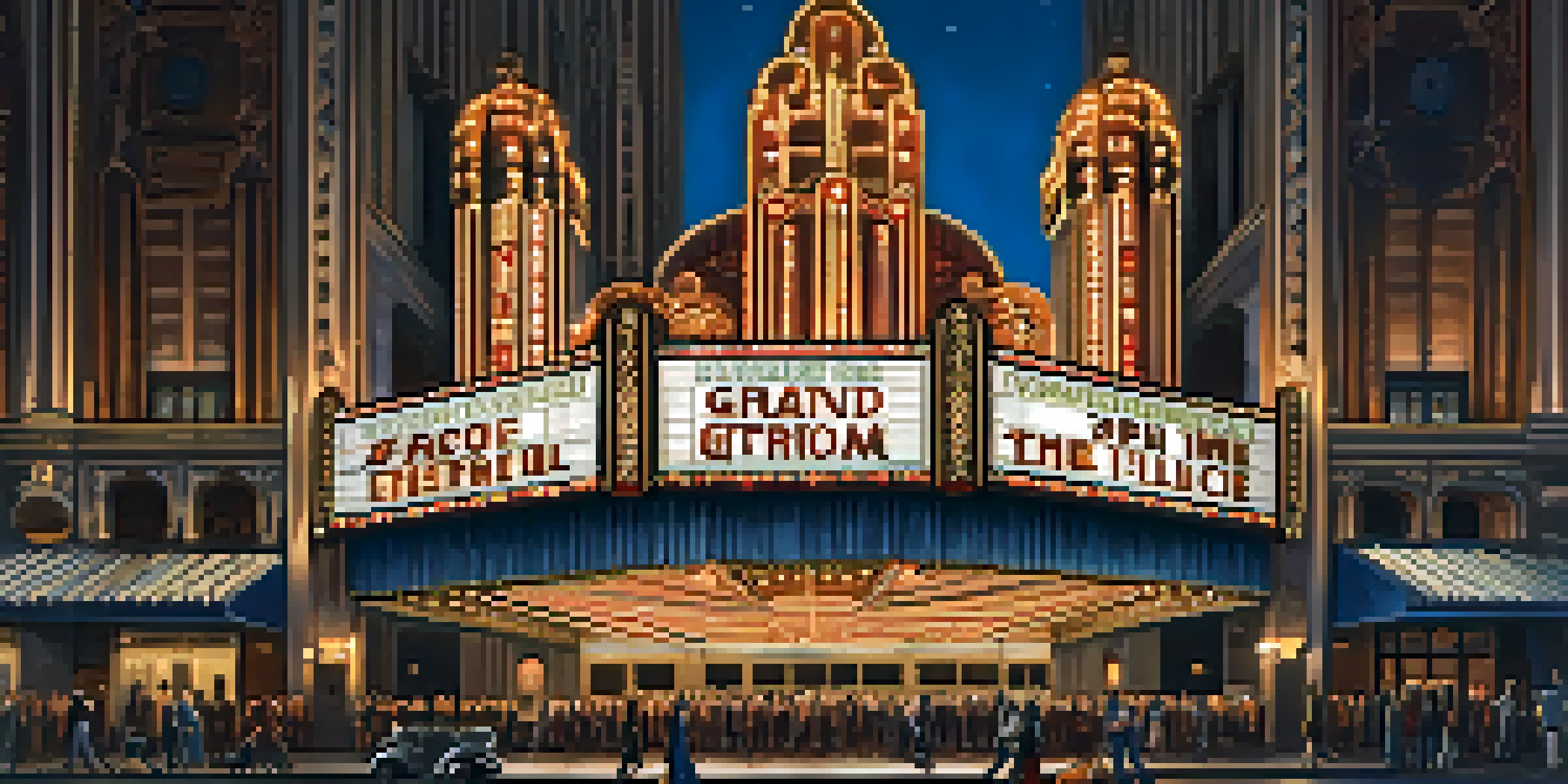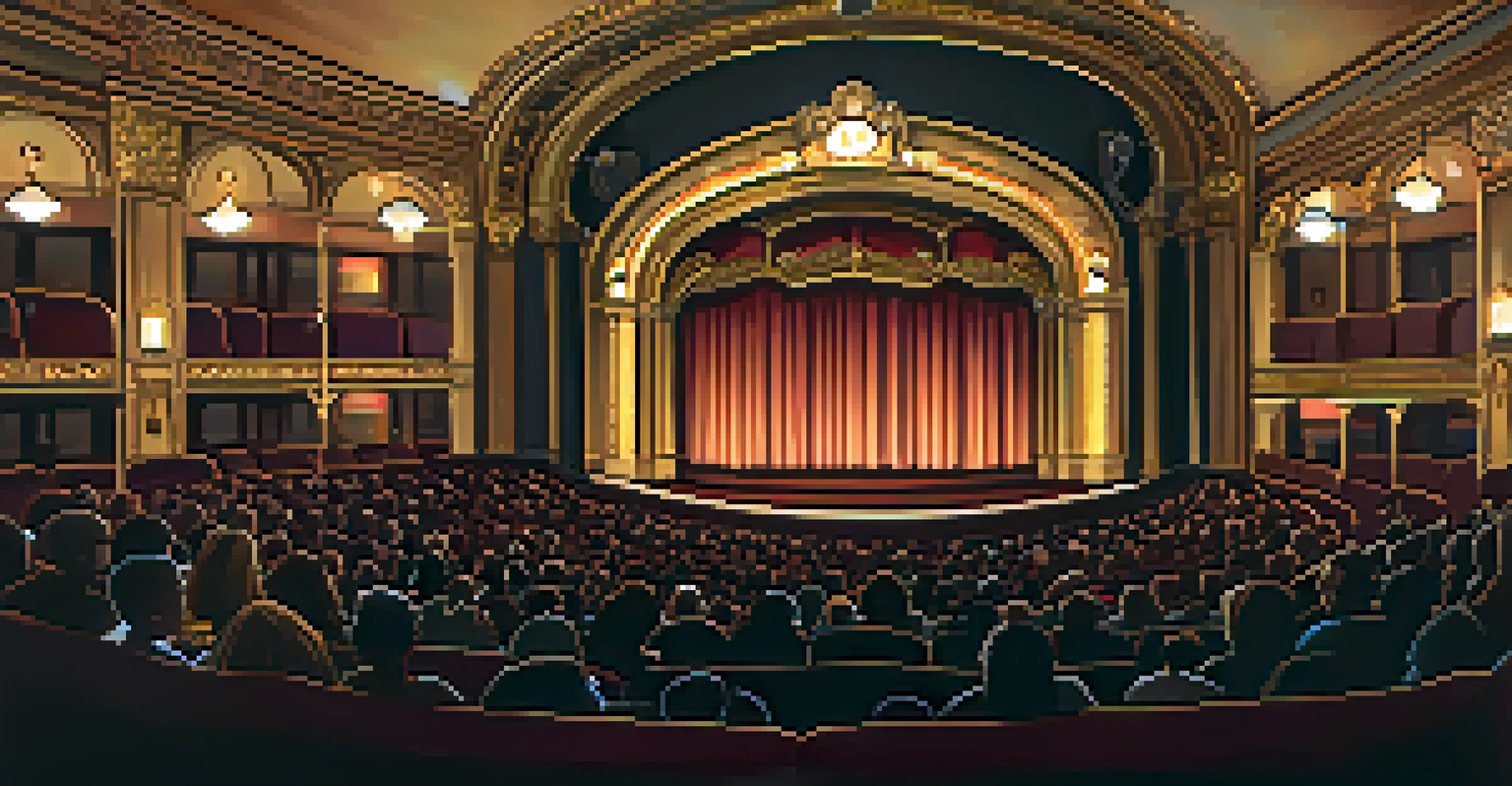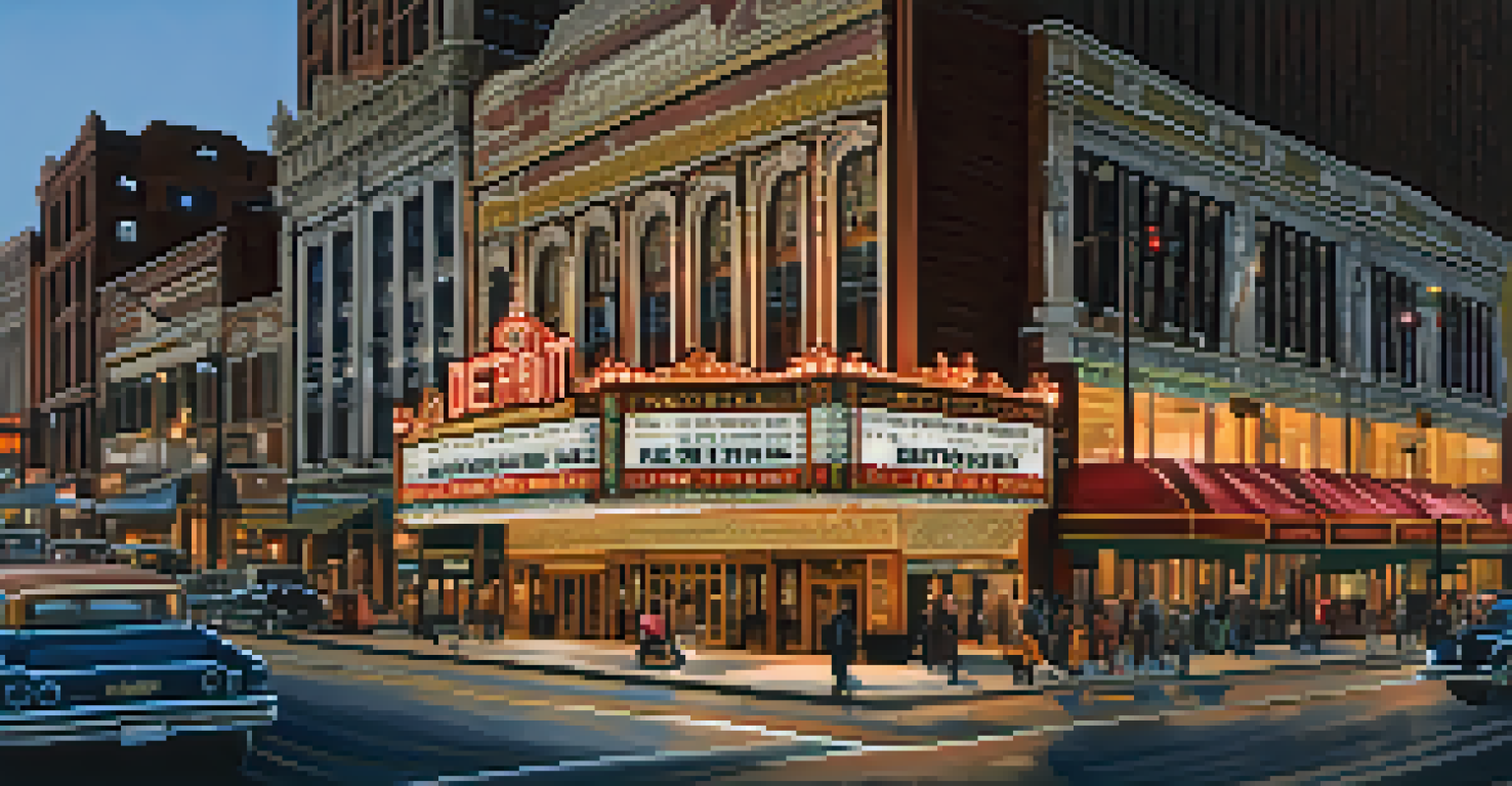Detroit's Iconic Theaters: A Look at Historic Architecture

A Brief History of Detroit's Theater Scene
Detroit's theater scene has a vibrant history that dates back to the late 19th century, showcasing the city's cultural evolution. From vaudeville performances to grand musicals, these venues have played a crucial role in shaping entertainment in the Motor City. As the city grew, so did the demand for more elaborate theaters that could host large audiences and grand productions.
The theater is a place where we can see ourselves, and the best of ourselves.
Many of these theaters were built during the golden age of cinema, reflecting the architectural trends of their time. The grandeur of these buildings speaks to the ambition and creativity of the city’s past. Today, they serve as a reminder of Detroit's rich artistic legacy and its ongoing commitment to the performing arts.
While some theaters have faced challenges over the years, many have been restored and continue to thrive. This resilience is a testament to the community's dedication to preserving the city's cultural heritage. Exploring these historic venues offers a glimpse into the heart of Detroit, where art and architecture intertwine.
The Fox Theatre: A Jewel of Art Deco Design
The Fox Theatre stands as one of Detroit's most recognizable landmarks, boasting stunning Art Deco architecture. Opened in 1928, it was originally designed as a movie palace and has since become a premier venue for Broadway shows and concerts. Its lavish interior features intricate plasterwork, a grand chandelier, and a celestial ceiling, transporting visitors to a different era.

The exterior of the Fox is equally impressive, with its towering marquee and ornate facade that beckons theatergoers from afar. It was designated a National Historic Landmark, ensuring that its architectural beauty will be preserved for future generations. This theater is not just a place to watch performances; it's an experience that embodies the glamour of Detroit's past.
Detroit's Theaters: Cultural Richness
Detroit's historic theaters reflect the city's vibrant cultural evolution and commitment to the performing arts.
Restoration efforts over the years have maintained its opulence while modernizing its facilities. The Fox Theatre continues to draw crowds, proving that great design and a love for the arts can stand the test of time. Visiting the Fox is a must for anyone wanting to appreciate Detroit's cultural landscape.
The Majestic Theatre: A Blend of History and Community
The Majestic Theatre, built in 1915, is a historic gem that showcases Detroit's eclectic architectural style. Originally a movie theater, it has evolved into a hub for live music and community events, reflecting the city's vibrant cultural scene. Its charming decor, complete with a stunning stained glass dome, creates an inviting atmosphere for patrons.
The arts are an essential part of our humanity; they help us see the world through a different lens.
What sets the Majestic apart is its commitment to supporting local artists and musicians, making it a beloved venue for both performers and audiences. The intimate setting allows for a unique connection between the stage and the audience, enhancing the overall experience. It's a place where creativity flourishes, and community bonds are strengthened.
The theater's adaptive reuse demonstrates the importance of preserving historic spaces while adapting to contemporary needs. By maintaining its original charm while offering modern amenities, the Majestic Theatre stands as a testament to Detroit's resilience and creativity. It's a perfect example of how historic theaters can thrive in today's cultural landscape.
The Detroit Opera House: A Marvel of Restoration
The Detroit Opera House showcases the city's dedication to the arts and historic preservation. Originally built in 1922, this stunning venue underwent a significant restoration in the 1990s, bringing back its former glory while enhancing its facilities. The Opera House is now a premier venue for opera, ballet, and other performing arts, offering a rich experience steeped in history.
The architectural elegance of the building is matched by its exquisite interior design, featuring intricate detailing and a majestic auditorium. It's a space that not only showcases performances but also elevates the art of theater itself. Each visit feels like stepping into a work of art, where every corner tells a story.
Preservation Ensures Future Enjoyment
Ongoing restoration efforts highlight the importance of preserving Detroit's theatrical heritage for future generations.
The Opera House stands as a symbol of Detroit's commitment to revitalizing its cultural landmarks. By investing in such historic spaces, the city ensures that future generations can enjoy the performing arts in a beautifully restored environment. It's a shining example of how history and modernity can coexist harmoniously.
The Fillmore Detroit: A Historic Venue with Modern Vibes
The Fillmore Detroit, originally known as the State Theatre, is a prime example of how historic venues can adapt to modern entertainment needs. Opened in 1925, it features a stunning blend of Renaissance and Baroque styles, making it one of Detroit's most beautiful concert halls. Its ornate interiors and intimate setting create a magical atmosphere for live performances.
The theater underwent a major renovation in the early 2000s, integrating state-of-the-art sound and lighting systems while preserving its classic charm. This thoughtful restoration ensures that it remains a top destination for artists and concertgoers alike. The Fillmore has hosted everyone from rock legends to contemporary artists, making it a staple in Detroit's music scene.
Beyond its architectural beauty, the Fillmore is a space that fosters community and connection through music. Each event brings together diverse audiences, creating a shared experience that transcends generations. The Fillmore stands as a testament to Detroit's vibrant cultural fabric and its love for live performances.
The Orchestra Hall: A Symphony of Architectural Elegance
Orchestra Hall, home to the Detroit Symphony Orchestra, is a masterpiece of early 20th-century architecture. Opened in 1919, it was designed with acoustics in mind, making it one of the finest concert halls in the country. The elegant design and intimate atmosphere create an unparalleled experience for classical music lovers.
The hall's recent renovations have preserved its historic charm while enhancing its functionality, allowing the orchestra to perform at its best. With its beautiful wood paneling and stunning chandeliers, Orchestra Hall is a feast for the eyes as well as the ears. It's a place where music comes alive, enveloping the audience in a rich auditory experience.
Community Engagement in the Arts
Local organizations are pivotal in promoting the arts and fostering appreciation for Detroit's historic venues.
Orchestra Hall also serves as a cultural hub, hosting a variety of performances beyond classical music. From jazz to popular concerts, the venue embraces a wide array of genres, making it accessible to all. This dedication to inclusivity reflects Detroit's commitment to fostering a vibrant arts community.
The History of the Detroit Theatre District
The Detroit Theatre District is a vibrant area filled with historic venues that represent the city's artistic heritage. Established in the early 20th century, this district was once the epicenter of entertainment in Detroit, attracting crowds with its dazzling theaters. Today, it remains a cultural hotspot, drawing visitors to its iconic locations.
Walking through the district, you can feel the echoes of the past in the architecture that surrounds you. Each theater has its own unique story, reflecting the diverse influences that shaped Detroit's cultural landscape. From the ornate facades to the intricate interiors, these theaters are a testament to the city's commitment to the arts.

The revitalization of the Theatre District has helped to breathe new life into these historic venues. Ongoing efforts to preserve and promote the arts ensure that future generations will continue to enjoy the rich cultural offerings of Detroit. The district stands as a vibrant reminder of the city's artistic spirit and its enduring legacy.
Preserving Detroit’s Theatrical Heritage for Future Generations
As we explore Detroit's iconic theaters, it's essential to recognize the importance of preserving these cultural treasures. Restoration efforts not only maintain the architectural integrity of these buildings but also honor the history and memories they hold. By investing in preservation, we ensure that future generations can experience the magic of live performance in these remarkable spaces.
Community engagement plays a crucial role in this preservation mission. Local organizations and advocates work tirelessly to promote the arts and raise awareness about the significance of these historic venues. Through educational programs and outreach, they inspire a new generation of theatergoers and artists, fostering a deep appreciation for the arts.
Ultimately, preserving Detroit's theatrical heritage is about more than just maintaining buildings; it's about keeping the spirit of creativity and innovation alive. Each theater is a chapter in the city's story, and by honoring these spaces, we celebrate the rich cultural tapestry that makes Detroit unique. Together, we can ensure that the lights continue to shine brightly on these historic stages.